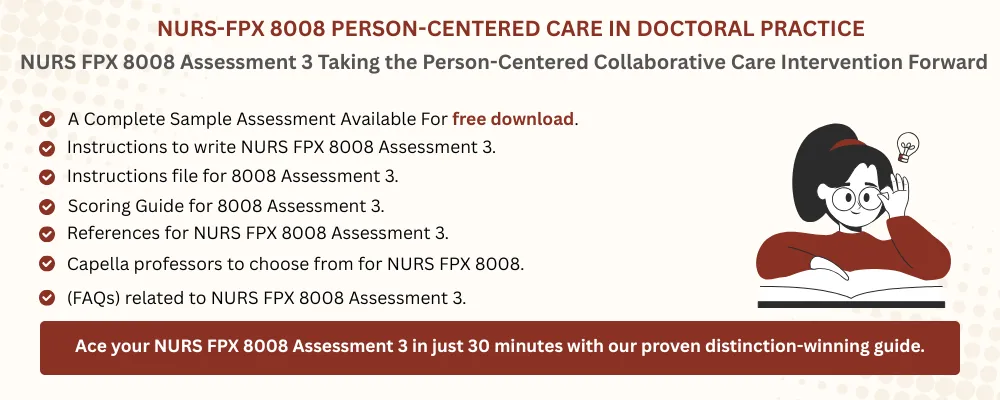NURS FPX 8008 Assessment 3 Sample FREE DOWNLOAD
NURS FPX 8008 Assessment 3 Taking the Person-Centered Collaborative Care Intervention Forward
Student name
Capella University
NURS-FPX8008
Professor Name
Submission Date
Taking the Person-Centered Collaborative Care Intervention Forward
Person-centered care (PCC) is a healthcare delivery model that centers on the individual, respecting their values, preferences, and personal experiences. An engaged model supports clinical outcomes and emotional wellness, meaning it facilitates a transition to more ethical, humanitarian, and cooperative strategies. The increased attention to individualized care suggests the need for healthcare systems that not only cure illnesses but also recognize the dignity, independence, and trust that individuals have in one another (Curcio et al., 2024).
The paper below relates to a specific intervention grounded in the theory of human caring, as proposed by Watson. The development of a research-based implementation plan, comparison of current and planned performance measurements, compatibility with institutional goals, and implementation of a predictive evaluation plan through the plan-do-study-act (PDSA) cycle are the most important aspects.
Strategic Outline for Person-Centered Care Intervention
The proposed PCC intervention will be implemented over a 12-week period, which will include aligning stakeholders, providing education, engaging patients in activities, and planning for sustainability evaluation and planning. During weeks one and two, nurses, physicians, and allied health staff will undergo intensive training in the PCC principles, based on the theory of human caring developed by Jean Watson, with a focus on holistic, empathetic, and ethically informed communication.
The structured patient orientation sessions will be held in weeks three to five, during which participants with chronic conditions will be included in the care planning process based on the principles of shared decision-making and the principles of care (FoC) model. Shared decision-making practices have been discovered to increase treatment adherence, health outcomes, and satisfaction in individuals with chronic conditions in particular (Newman et al., 2021). Simultaneously, family involvement will be encouraged to enhance support networks and continuity of care.
The period from weeks six to nine will be dedicated to incorporating interprofessional collaboration strategies, such as weekly multidisciplinary meetings to organize individualized care pathways and discuss the physical, emotional, and social needs of patients. The use of digital engagement tools, such as patient portals and telehealth check-ins, will be employed to promote self-management and ongoing communication. Official assessments of patient-reported outcome measures (PROMs), safety indicators, and satisfaction polls, as well as staff meetings, will be conducted during the tenth, twelfth, and thirteenth weeks to streamline procedures.
The anticipated results include at least a 20% improvement in patient satisfaction rates, a 15% reduction in unnecessary readmissions, increased medication compliance rates, and enhanced patient control over the treatment of chronic illnesses. Digital health tools, when combined with interprofessional collaboration, have been found to significantly enhance the outcomes of care coordination, patient engagement, and chronic care management (Wannheden et al., 2022). Qualitative results will include enhanced patient-provider trust, improved interdisciplinary collaboration, and a culture of care that consistently aligns with ethical standards, including autonomy, beneficence, and non-maleficence, ultimately leading to long-term clinical and experiential health outcomes.
Comparison of Current and Targeted Data Metrics Using the PDSA Model
The assessment of the effects of the person-centered care intervention should be conducted through a structured PDSA approach, relating existing metrics to the desired changes. During the planning phase, the team gathered and reviewed baseline data, which indicated that medication adherence was 65%, the 30-day readmission rate was 18%, and patient satisfaction scores averaged 72%. Only half of the patients felt engaged in the decision-making process regarding their care. The goal of the program is to achieve 85 percent medication adherence. The adherence rates also improved similarly in the intervention study of Baryakova et al. (2023).
The program aims at reducing the 30-day hospital readmission rate to 12 percent. A similar decrease in readmissions was reported in Dhaliwal and Dang (2024). The program aims to achieve a patient satisfaction rate of 90 percent. According to Chen et al. (2022), the use of patient-centered strategies did not produce higher levels of satisfaction. The program will also aim to increase engagement in care planning to 80 percent. The rate of participation in care planning according to Valentine et al. (2020) was higher following organized involvement programs.
The implementation of specific measures will be introduced in the so-called ‘do’ phase, including systematic follow-up with pharmacy refill monitoring, proactive multidisciplinary discharge planning, shared decision-making tools, and communication training based on Jean Watson’s theory of human caring. The FoC framework will be used to merge respect, emotional support, and patient priorities into everyday practice.
Pharmacy refill data, electronic health record monitoring, PROMIS-29 scores, patient activation measure results, and national readmission data will be used to measure progress during the study phase. Interdisciplinary communication will also be measured through staff surveys, to achieve a 20 percent improvement in coordination (Nazmeen et al., 2024). The results will be measured against national standards of satisfaction to determine effectiveness.
The act phase will focus on maintaining practices that achieve or surpass the objectives and revising strategies that are not performing effectively. Meeting the benchmarks will confirm the value of person-centered interventions in disease control, patient autonomy, and the strain on hospital resources, as well as the integration of compassionate and evidence-based care into the organizational culture.
Strategic Alignment of Person-Centered Care with Organizational Goals
Two of the most valuable organizational objectives are directly supported by the person-centered care intervention. To begin with, the PCC enhances patient experience and engagement through shared decision-making, holistic care, and emotional support, which aligns with the focus on patient dignity and engagement (Valentine et al., 2020). Secondly, PCC is linked to improvements in the quality of care by reducing readmissions and increasing medication adherence, which in turn helps achieve better outcomes in chronic illnesses. The intervention will be consistent with value-based care and promote long-term sustainability through evidence-based practices and performance monitoring (Nazmeen et al., 2024). The strategy not only instills confidence in patients but also enhances organizational performance in a manner that enables evidence-based care to be translated into measurable and sustainable health outcomes.
The intervention enables the building of trust, empathy, and personalized interaction, which, respectively, facilitate achieving the highest quartile of patient satisfaction with care, as patients become an integral part of clinical interactions through the application of the theory of human caring, developed by Jean Watson. Education in formal communication and joint decision-making programs ensures that care planning remains patient-focused, promoting a culture of respect and cooperation that results in long-term loyalty and improvement of the organizational image. The project’s goals also include reducing readmission rates and enhancing clinical outcomes.
A structured discharge process, pharmacy follow-up, and proactive care transition planning ensure that patients leave with clear instructions, support available, and a follow-up appointment. The goals of these measures are to stabilize chronic conditions and identify post-discharge complications early, thereby avoiding unnecessary hospitalizations and conserving acute care resources (Valentine et al., 2020). The PDSA model utilizes patient-reported outcome measures and a constant feedback loop to ensure that refinements are evidence-based, thereby making the organization even more dedicated to quality improvement. By integrating the values of caring care with the process implementation focused on results, the intervention will be able to develop a repeatable model of high patient satisfaction and operational efficiency.
Conclusion
The person-centered care intervention fosters meaningful clinician-patient relationships built on respect, empathy, and shared decision-making. Engagement, satisfaction, and health outcomes are measurable through structured implementation with set timelines and ongoing monitoring. Such evidence-based strategies as holistic care planning and active follow-up contribute to the quality and reduce readmissions. A culture of dignity, participation, and sustainable value-based care is supported by alignment with organizational goals. The net effect is that the organization has become a leader in delivering high-impact, compassionate healthcare.
Related Free Assessments for NURS-FPX8008
Instructions To Write NURS FPX 8008 Assessment 3
Need guidance for NURS FPX 8008 Assessment 3: Taking the Person-Centered Collaborative Care Intervention Forward? Contact Tutors Academy today for expert assistance!
Instruction file for 8008 Assessment 3
Contact us to get the instruction file for this assessment.
Scoring Guide for 8008 Assessment 3
Contact us to get the Scoring file for this assessment.
References For NURS FPX 8008 Assessment 3
Baryakova, T. H., Pogostin, B. H., Langer, R., & McHugh, K. J. (2023). Overcoming barriers to patient adherence: The case for developing innovative drug delivery systems. Nature Reviews Drug Discovery, 22(22), 1–23. https://doi.org/10.1038/s41573-023-00670-0
Curcio, F., Marzia Lommi, Nury, R., Esteban-Burgos, A. A., Pucciarelli, G., & Iván, C. (2024). Identifying and exploring Jean Watson’s Theory of Human Caring in nursing approaches for patients with psychoactive substance dependence in medical and surgical acute wards. Nursing Reports, 14(3), 2179–2191. https://doi.org/10.3390/nursrep14030162
Dhaliwal, J. S., & Dang, A. K. (2024, June 7). Reducing hospital readmissions. Nih.gov; StatPearls Publishing. https://www.ncbi.nlm.nih.gov/books/NBK606114/
Nazmeen, S., Iqbal, T., Fatima, J., & Sultan, B. (2024). Application of Jean Watson’s theory to a patient with polytrauma. National Journal of Health Sciences, 9(2), 137–139. https://doi.org/10.21089/njhs.92.0137
Newman, B., Joseph, K., Chauhan, A., Seale, H., Li, J., Manias, E., Walton, M., Mears, S., Jones, B., & Harrison, R. (2021). Do patient engagement interventions work for all patients? A systematic review and realist synthesis of interventions to enhance patient safety. Health Expectations, 24(6), 1905–1923. https://doi.org/10.1111/hex.13343
Valentine, K. D., Vo, H., Fowler, F. J., Brodney, S., Barry, M. J., & Sepucha, K. R. (2020). Development and evaluation of the shared decision-making process scale: A short patient-reported measure. Medical Decision Making, 41(2), 108-119. https://doi.org/10.1177/0272989×20977878
Wannheden, C., Wennerholm, M., Dahlberg, M., Revenäs, Å., Tolf, S., Eftimovska, E., & Brommels, M. (2022). Digital Health Technologies Enabling Partnerships in Chronic Care Management: A Scoping Review (preprint). Journal of Medical Internet Research, 24(8), e38980. https://doi.org/10.2196/38980
Best Professors To Choose From For 8008 Class
- Donna Ryan, DNP, MSN.
- Michael Ruth, DNP, MSN.
- Angela Saathoff, DNP, MSN, BSN.
- Eunice Rosas, DNP, MSN.
- Jill Schramm, DNP, MSN, MS, BSN.
(FAQs) related to NURS FPX 8008 Assessment 3
Question 1: From where can I download a free sample for NURS FPX 8008 Assessment 3?
Answer 1: You can download a free sample for NURS FPX 8008 Assessment 3 from the Tutors Academy website.
Do you need a tutor to help with this paper for you with in 24 hours.
- 0% Plagiarised
- 0% AI
- Distinguish grades guarantee
- 24 hour delivery

